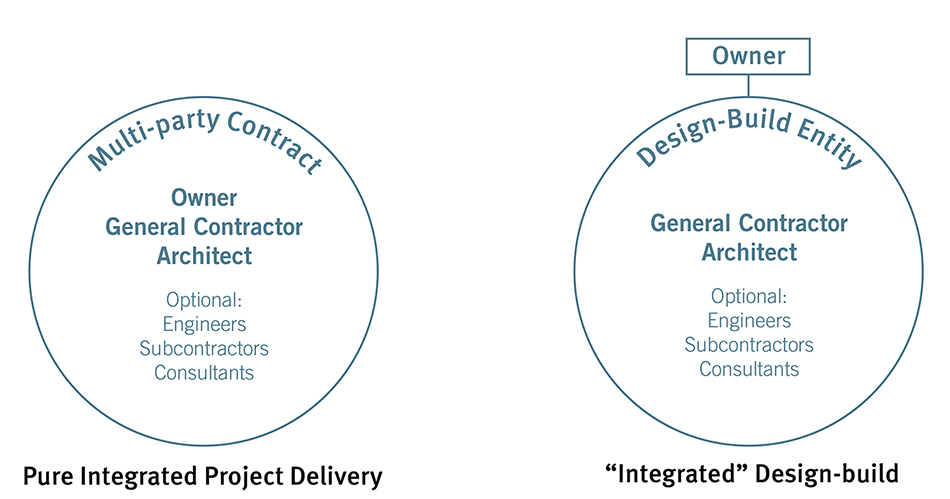Selecting a Model
It might be possible to create alignment with a really great team and pursue an integrated process with a conventional design-bid-build business model, but risk management and financial terms ultimately determine how businesses and firms relate. If these structures don’t also change, it will be difficult to extend integration beyond a select group of people to the organizations for which they work. Even in alternative delivery models, like Design-Build or Construction Manager at Risk, those committed to an integrated approach end up expending energy to circumvent status quo policies, which is not impossible but is also not the easiest course. Integration is most likely to succeed if it is the path of least resistance, from both an individual and a corporate standpoint, which is accomplished by aligning incentive structures with this new way of engaging—something best achieved with an Integrated Project Delivery contracting approach.
The choice of contract structure is typically driven by the owner. However, pursuing an integrated contracting model may be suggested by any stakeholder. Integrated Project Delivery aligns incentive structures by contractually linking two or more parties’ risk and profit. These contracts typically include three distinct mechanisms for sharing the financial risk and benefits in a project.
Selecting a Contract
Integrated Project Delivery (IPD) contracts give all those who participate in the risk and reward structure (at minimum the owner, architect, and general contractor) joint project control, which ensures that those who are accepting the risk have a voice in the decision-making.
This is accomplished in one of two ways:
- Multi-party contracts bind the owner, architect, and general contractor together in the risk and reward structure, and sub-agreements are added for subcontractors and consultants so that they share in the portion of the at-risk compensation but have limited or no voting rights at the management level (Figure 4).
- Poly-party contracts bring more team members into the shared risk-reward structure, and all members have a vote or veto power on major decisions. In addition to the owner, designer, and builder, key participants may include mechanical, electrical, or plumbing contractors if they can provide valuable input about constructability and cost. Depending upon the project, steel erectors, framers, curtain wall contractors, major equipment vendors, and others may similarly be key participants (Ashcraft n.d.).

Figure 4: Multi-party contract structure
Figure 5: Integrated Design-Build contract structure
IPD contracts further support integration because they require:
- joint project control, including the owner,
- early involvement of key participants, like trade subcontractors and consultants,
- jointly developed and validated goals, and
- liability waivers.
IPD contracts are not adopted equally between the US, Canada and Mexico. The US has publicly available IPD contracts that can be adapted to various projects. These include the ConsensusDocs 300 and the American Institute of Architects’ (AIA) C191. Canada currently does not have a standard form of multi-party contract for IDP projects, but the Canadian Construction Documents Committee is currently working on a standard form, relying heavily on AIA precedents. IPD projects have been carried out in Canada, however, using custom contracts. In Mexico, multi-party contracts are not currently part of integrated practice, although practitioners do engage with integrated design through the Leadership in Energy and Environmental Design (LEED) rating program.
Negotiating
In some cases, financial incentives can disrupt an intrinsic motivation to act more collaboratively, as might be the case if the team is driven solely by the goal of creating a green building. To mitigate this possibility:
- Conduct an alignment workshop before negotiating the contract.
- Approach contracts as a license for creative freedom, not a prescriptive set of conditions.
- Reiterate jointly developed values throughout the project and at important transitions.
Case Study: Mosaic Center